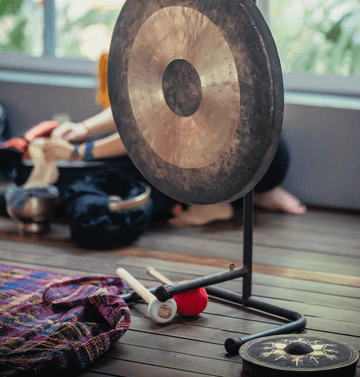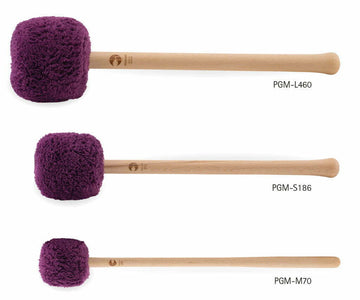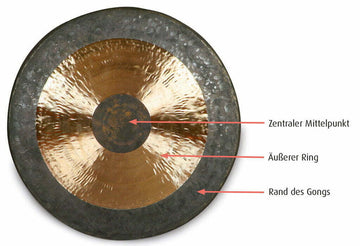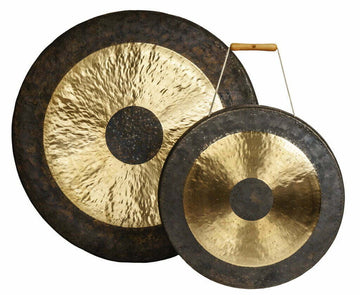
The most important facts in brief
- The gong is played with a mallet or rubbing instrument.
- The location and the objects in a room determine the sound quality when playing the gong.
- The larger the gong, the more practical experience is usually required.
- Driving a gong requires a little more practice than strike.
- Gongs are used in sound meditations, sound massages and yoga classes.
Preparation: How to prepare the gong game
Whether you are practising alone or for a group - before you start playing the gong, you should make a few preparations. This will allow the full sound of your instrument to unfold unhindered and you or your participants can fully engage in the experience.
Placement of the gong
You should choose the room and the exact location for your instrument carefully so that the sound waves of your gong can develop as unadulterated as possible. The sound waves that unfold while playing the gong are influenced by the size of the room and other objects in it, among other things.
Sound reflections, which are not always easy to perceive, can change the original sound quality of your gong, for example by lengthening the sound or coloring it differently. Some surfaces also absorb the sound. For example, curtains or carpets can dampen high frequencies or cavity walls can absorb low frequencies.
Tip
It is best to place your gong in a place where there is an equal amount of space in front of and behind the instrument and where there are as few disturbing objects as possible on both sides.
Choice of mallet
Another must-have for your sound practice is the right gong mallet. You will achieve the best results with a high-quality mallet or gong mallet that is matched to the size and type of your gong and the desired sound frequency. There are a whole range of different mallet types - the basic rule is: the larger your gong, the larger the mallet should be.
High-quality gong mallets, such as those you can find in our store, produce little or no striking noise - this has a huge impact on the sound experience. When choosing your mallet or grater, pay attention not only to your individual needs but also to the materials used and the weight. If in doubt, always seek advice from an expert.
Note
Mallets with a smaller head produce brighter tones than those with a larger head.

Instructions: How do I strike a gong correctly?

Whether you are a beginner or an advanced player, you should take plenty of time to explore the different areas of your gong. Over time, you will gain more and more control over the volume and rhythm and become more and more comfortable with intuitive playing.
Gong "warm up"
Many gong players warm up the gong before they actually start playing. This involves "tapping" the gong very lightly a few times with a mallet before strike playing. The tapping should be relatively inaudible. This procedure is intended to make the sound brighter overall.
Gong striking techniques
As an experienced player, you will continue to develop your playing techniques: Experiment with different striking points, single and combination strokes. To further deepen your practice, you can try your hand at hand gongs as well as hanging gongs.
The larger the gong, the more an understanding of precise strike is required. At the Peter Hess® Institute you will not only learn how to set up different playing sequences, the training courses also teach the holistic and valuable work in sound therapy and sound massage.
Instructions: How do I rub a gong?
Rubbing a gong with a gong grater produces sounds ranging from gentle to effervescent. The gong is set into vibration and produces long-lasting tones. The resulting sound is reminiscent of the chanted mantra "Om" or whale and dolphin song.
In this technique, the grater is carefully moved in a circle over the surface, causing the gong to vibrate gently. The longer you rub, the stronger the sound that is produced. The rubbing is only carried out with light pressure.
The technique of rubbing requires a little more experience than strike the gong. As an advanced player, the best way to learn is by experimenting: Explore the three gong playing zones and notice the difference in the tones. You can also use your fingertips when playing. With a little practice and the right amount of pressure, you can create completely different timbres.
Tip
To "warm up" the gong, tap it gently once before rubbing it.
Caution: During pregnancy and in the case of acute physical or psychological complaints, please only use after consulting your doctor.
Possible uses of the gong
Within the Peter Hess® Sound Massage and the Peter Hess® Sound Methods there are numerous sound elements and sound settings in which the TamTam Gong and the Feng Gong are used.
A sound setting is the environment in which you carry out your sound practice with your sound instrument.
For example, in the Peter Hess® Sound Pedagogy developed by Peter and Emily Hess, there is a setting called "Dance of Life" in which four TamTam gongs are used.
Gongs are also an important element for fantasy and sound journeys, sound meditations and concerts. The meditative soundscapes with gongs and Singing Bowls by Peter Gabis, for example, give a wonderful impression of this. You can experience how the sounds unite to form a flow by listening to his CD Pravaaha or watching the short video.
The main areas of application of the gong:
- Sound massages and sound methods
- Sound meditations
- Sound and fantasy journeys
- Concerts
Video Rhythms of Silence
Watch the live concert by Peter Gabis and immerse yourself in a world of silence behind the rhythm.
Playing the gong during sound meditations
The sound of the gong can help you or your participants to reduce stress and find inner peace and balance. For this to really work, you should already have some experience of playing the gong and be familiar with your instrument. The less you have to concentrate on the handling during the gong meditation, the more you can focus on your own sensations or on leading your meditation group.
Preparation of the pitch
Prepare the room in which the sound meditation is to take place with mindfulness. There should be a pleasant atmosphere and a comfortable climate. Air the room a few minutes before you start and set up the place where you are going to play. Perhaps you have a meditation cushion and play sitting down; or your gong allows you to play standing up or moving. You may also play your instrument outside in nature.
Ensure peace and quiet
Whether you play indoors or outdoors - make sure that your chosen location is quiet. The less distraction there is from everyday noises, the more you or your participants can engage with the sound experience.
Initiate meditation
Start with breathing exercises to arrive at the place where you are. If you are practicing just for yourself, find a comfortable seat or lie on your back in Shavasana for a few minutes to get in the mood for your practice. If you are playing for others, a breathing meditation can help prepare your participants optimally for the effect of the vibrations of the gong.
As soon as you have calmed down, you can slowly start to play the gong with the mallet or grater. Start with gentle sounds and increase the intensity towards the middle of the meditation. Try to keep your eyes closed as much as possible or ask your participants to do so at the beginning. In this way, the focus can be fully directed towards the penetrating sound experience.
Addressing specific areas of the body
Different frequencies address different regions or energy fields of the body. For example, warm and bright tones are better suited to the heart area or the head, while low tones mainly address the abdomen and lower back.
Each energy center in the body is assigned a specific frequency or tone. Depending on which tradition you follow, the information is slightly different and different frequencies and therefore tones are assigned. Here too, it is good advice to listen to your own feelings and experiment with the sounds.
Caution: During pregnancy and in the case of acute physical or psychological complaints, please only use after consulting your doctor.

Playing the gong during sound massages
Sound massage with a gong can support the self-healing powers of people who are undergoing medical or therapeutic treatment, or those who want to do something specifically for their health.
The relaxation and harmonization of soul, mind and body can help to strengthen a person's health. The spherical vibrations set every cell of the body vibrating and leave a gentle tingling sensation, clarity and vitality even hours after the experience.
During a sound massage, the gong is placed at a point in the room where the sound can best unfold and penetrate the body down to cellular level. The sound practitioner uses a specific playing technique that generates different frequencies and intensities and thus addresses different areas of the body. If meditation is done without Singing Bowls and only gongs are used, several gongs are usually used. They are placed in the space around the person's body and played one after the other.

"The interplay of the gongs is a very powerful tool for transporting people even deeper into a meditative state."






